The Bond Market Outlook for 2025: Navigating a Complex Landscape
As we approach 2025, the bond market presents a multifaceted environment shaped by evolving economic conditions, central bank policies, and geopolitical developments. Investors must stay informed and adaptable to effectively navigate this landscape.
INVESTMENT GRADE CORPORATE BONDS LEARN MORE: Investment Grade Corporate Bonds
Economic Context and Interest Rates
Global Economic Conditions
The global economy is stabilizing post-pandemic, with the U.S. projected to maintain a steady growth rate of around 2%, aligning with its long-term trend. However, geopolitical tensions and trade uncertainties could impact this outlook.
Federal Reserve Policies
The Federal Reserve is anticipated to adopt a more accommodative monetary policy, with potential interest rate cuts to support economic growth. Market expectations suggest a series of rate reductions through 2025, aiming to bring the federal funds rate down to approximately 3.75% by late 2025.
Global Monetary Trends
Other central banks, including the European Central Bank and the Bank of England, may also consider easing monetary policies to stimulate growth, impacting global bond markets.
Investment Grade Bonds
Expected Performance
Investment grade bonds are expected to offer attractive opportunities, serving as a cornerstone for income generation and risk management within diversified portfolios. Projections indicate annualized returns of 4.3% to 5.3% over the next decade.
Factors Influencing Investment Grade Bonds
- Economic Stability: Steady economic growth supports corporate earnings, enhancing issuer creditworthiness.
- Interest Rate Movements: Potential rate cuts by the Fed could lead to capital appreciation for existing bonds as newer issues come with lower yields.
- Investor Demand: Attractive yields may increase allocations to high-quality fixed income assets.
Strategies for Investors
- Duration Management: Balancing portfolio duration to hedge against interest rate fluctuations.
- Credit Analysis: Focusing on sectors with strong fundamentals and issuers with robust balance sheets.
- Diversification: Including a mix of corporate and government bonds to spread risk.
High Yield Bonds
Market Expectations
The high yield bond market offers higher returns but comes with increased risk. Yields for U.S. high yield bonds could hover around 7.2%, while European counterparts might offer around 5.6%.
Risks and Opportunities
- Credit Spreads: Tight spreads suggest limited compensation for risk, necessitating careful issuer selection.
- Economic Cycles: High yield bonds are sensitive to economic downturns; monitoring economic indicators is crucial.
- Liquidity Considerations: Market liquidity can impact the ability to buy or sell high yield bonds without affecting prices significantly.
Default Rates
While default rates are expected to decline, they remain a critical factor. Investors should:
- Assess Credit Risk: Evaluate the financial health of issuers, particularly in vulnerable sectors.
- Monitor Refinancing Needs: Be aware of companies with significant debt maturing, which may face refinancing challenges.
Market Dynamics and Risks
Political Landscape
The political environment in 2025 could introduce volatility into bond markets. Factors to consider include:
- U.S. Elections: The outcome could influence fiscal policies, trade agreements, and regulatory frameworks.
- Geopolitical Tensions: Ongoing trade disputes or conflicts may impact global economic stability, affecting bond yields and investor confidence.
Credit Spreads
While credit spreads are tight, they may remain narrower due to healthy credit fundamentals and strong investor demand for higher-yielding bonds.
Supply Trends
- Bond Issuance: Companies may increase bond issuance to secure favorable financing terms ahead of potential policy shifts or economic changes.
- Market Absorption: The market’s ability to absorb new issuance without significant spread widening is a factor to watch.
Global Economic Divergence
Economic performance is expected to vary across regions:
- United States: Potentially outperforming other advanced economies due to resilient consumer spending and technological innovation.
- Europe and Asia: May experience slower growth, with policy responses affecting local bond markets differently.
Sector-Specific Opportunities
Counter-Cyclical Sectors
Investors might find value in sectors that perform well regardless of economic cycles:
- Healthcare: Large healthcare firms offer stability due to consistent demand for medical services and products.
- Consumer Staples: Companies providing essential goods may offer steady returns.
Technology and AI
- Innovation Drivers: Technology firms benefiting from advancements in artificial intelligence and digital transformation present growth opportunities.
- Credit Quality: Established tech companies often have strong credit profiles, making their bonds attractive.
Non-Cyclical Issuers
- Utilities: Provide essential services with predictable revenue streams.
- Senior-Ranking Bank Bonds: Particularly in stable markets like the UK, these bonds offer security due to regulatory protections.
Strategic Considerations
Duration Management
- Active Management: Adjusting portfolio duration in response to interest rate expectations can enhance returns.
- Yield Curve Positioning: Focusing on specific maturities that offer the best risk-return trade-off.
Geographic Diversification
- International Exposure: Including bonds from countries like the UK and Australia, which may offer attractive real yields and diversification benefits.
- Currency Hedging: Managing currency risk when investing in foreign bonds.
Credit Quality Focus
- High-Quality Credits: Prioritizing bonds from issuers with strong credit ratings to mitigate default risk.
- Sector Analysis: Evaluating sectors less susceptible to economic downturns.
The bond market in 2025 is expected to present a blend of opportunities and challenges. Investment grade bonds offer a balance of income and risk mitigation, while high yield bonds provide higher returns with increased risk. Market dynamics such as political developments, credit spreads, and global economic divergence will shape the investment landscape.



